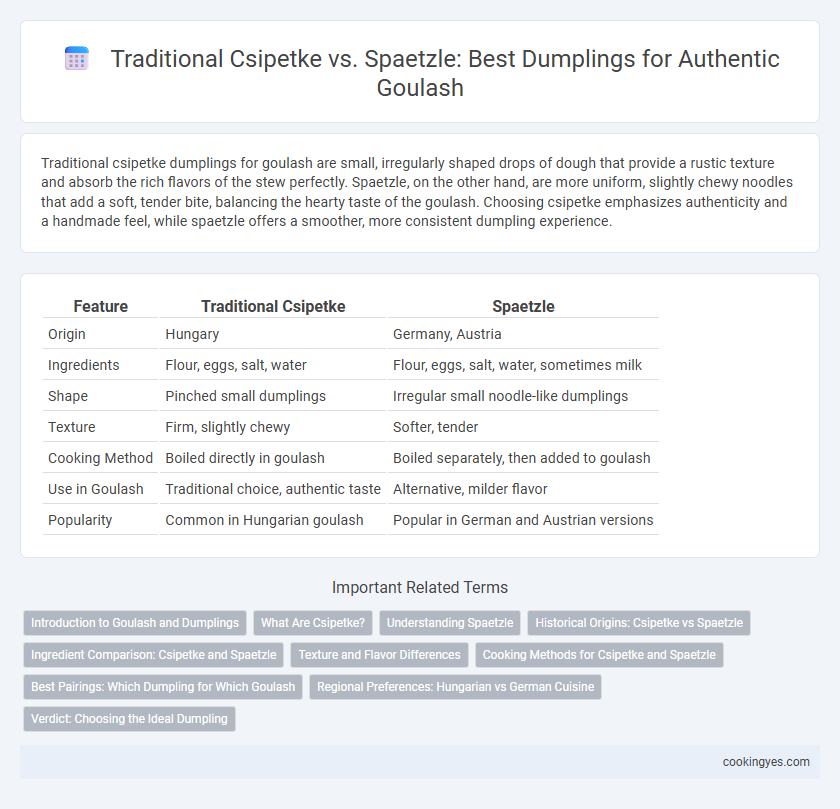Traditional csipetke dumplings for goulash are small, irregularly shaped drops of dough that provide a rustic texture and absorb the rich flavors of the stew perfectly. Spaetzle, on the other hand, are more uniform, slightly chewy noodles that add a soft, tender bite, balancing the hearty taste of the goulash. Choosing csipetke emphasizes authenticity and a handmade feel, while spaetzle offers a smoother, more consistent dumpling experience.
Table of Comparison
| Feature | Traditional Csipetke | Spaetzle |
|---|---|---|
| Origin | Hungary | Germany, Austria |
| Ingredients | Flour, eggs, salt, water | Flour, eggs, salt, water, sometimes milk |
| Shape | Pinched small dumplings | Irregular small noodle-like dumplings |
| Texture | Firm, slightly chewy | Softer, tender |
| Cooking Method | Boiled directly in goulash | Boiled separately, then added to goulash |
| Use in Goulash | Traditional choice, authentic taste | Alternative, milder flavor |
| Popularity | Common in Hungarian goulash | Popular in German and Austrian versions |
Introduction to Goulash and Dumplings
Goulash, a rich Hungarian stew, is famously paired with dumplings that absorb its spicy, paprika-infused sauce. Traditional csipetke dumplings are small, pinched noodles made from a simple flour and egg dough, offering a chewy texture that contrasts with the tender meat. Spaetzle, more common in German cuisine, are irregularly shaped, soft noodles that provide a lighter, softer bite, making both types popular choices depending on regional preferences.
What Are Csipetke?
Csipetke are small, pinched Hungarian dumplings traditionally used in goulash, made from a simple dough of flour, eggs, and water, then quickly dropped into the simmering stew. Unlike spaetzle, which are often softer and larger with a looser consistency, csipetke have a denser texture and irregular shape due to their hand-pinched preparation. This distinct texture allows csipetke to absorb the flavorful paprika-rich broth of goulash while maintaining a slight chewiness that complements the hearty meat and vegetables.
Understanding Spaetzle
Spaetzle, a soft egg noodle dumpling originating from Swabian and Franconian regions, differs from traditional csipetke by its chewier texture and slightly irregular shape, achieved through a special batter scraped directly into boiling water. While csipetke are small, pointed dumplings made from a firmer dough, spaetzle provide a more tender contrast that absorbs goulash's rich paprika sauce effectively. Understanding spaetzle's unique preparation enhances appreciation of its role in harmonizing with the savory depth of Hungarian goulash.
Historical Origins: Csipetke vs Spaetzle
Csipetke, originating from Hungarian culinary tradition, are small, hand-pinched dumplings historically crafted to complement rich goulash stews, reflecting the region's rustic, hearty cuisine. Spaetzle, with roots in German and Austrian gastronomy, are soft noodle-like dumplings made by pressing dough through a colander or scratching it off a board into boiling water, symbolizing Central European noodle-making techniques. Both dumplings showcase distinct historical origins and preparation methods that highlight the diverse cultural influences surrounding goulash dishes.
Ingredient Comparison: Csipetke and Spaetzle
Csipetke, traditional Hungarian dumplings for goulash, consist primarily of flour, eggs, and water, creating a denser texture perfect for soaking up rich stew flavors. Spaetzle, a similar Central European dumpling, incorporates milk or yogurt alongside flour and eggs, resulting in lighter, softer dumplings with a slightly tangy taste. The distinct ingredient ratios in csipetke and spaetzle influence their texture and absorbency, making csipetke ideal for hearty goulash while spaetzle suits creamier or more delicate sauces.
Texture and Flavor Differences
Traditional csipetke dumplings in goulash offer a denser, chewier texture with a slightly nutty flavor, derived from their hand-pinched shape and egg-rich dough. Spaetzle dumplings provide a softer, more tender bite and absorb the goulash sauce more readily, enhancing the stew's rich, savory profile. Choosing csipetke results in a heartier, more rustic experience, while spaetzle delivers a delicate contrast that complements the stew's depth.
Cooking Methods for Csipetke and Spaetzle
Traditional csipetke dumplings for goulash are hand-pinched from a thick, egg-enriched dough, requiring boiling directly in the simmering stew to absorb rich flavors. Spaetzle, on the other hand, involves pressing a loose batter through a colander or special spaetzle maker into boiling water, producing soft, slightly chewy dumplings often cooked separately before being added to the dish. Both methods influence texture and flavor absorption, with csipetke offering a denser bite and spaetzle providing a lighter, more tender complement to goulash.
Best Pairings: Which Dumpling for Which Goulash
Csipetke, small hand-pinched Hungarian dumplings made from flour, eggs, and water, best complement rich, paprika-heavy goulash by soaking up its robust, spicy sauce without overpowering the dish. Spaetzle, a German-origin egg noodle with a softer texture and mild flavor, pairs well with lighter, broth-based goulash variations where a more delicate dumpling balances the subtle flavors. Choosing csipetke enhances traditional Hungarian goulash authenticity, while spaetzle offers a tender, pillowy alternative suited for fusion or less intensely seasoned goulash recipes.
Regional Preferences: Hungarian vs German Cuisine
Traditional Hungarian goulash features csipetke, small pinched dumplings made from flour, egg, and water, which add a delicate texture that soaks up the rich paprika-infused broth. In contrast, German cuisine prefers spaetzle, soft egg noodles or dumplings with a chewier consistency that complement heartier, creamier goulash variations, reflecting regional taste preferences. These distinct dumpling styles highlight the cultural and culinary differences between Hungarian and German approaches to preparing and enjoying goulash.
Verdict: Choosing the Ideal Dumpling
Traditional csipetke dumplings, small pinched noodles made from simple flour and egg dough, offer a light and tender texture that absorbs the rich flavors of Hungarian goulash perfectly. Spaetzle, originating from German cuisine, tends to be larger and softer with a more substantial bite, providing a heartier accompaniment but potentially overshadowing the goulash's delicate balance. For an authentic Hungarian goulash experience, csipetke remains the ideal choice due to its size, texture, and complementary flavor profile.
Traditional csipetke vs spaetzle for goulash dumplings Infographic

 cookingyes.com
cookingyes.com